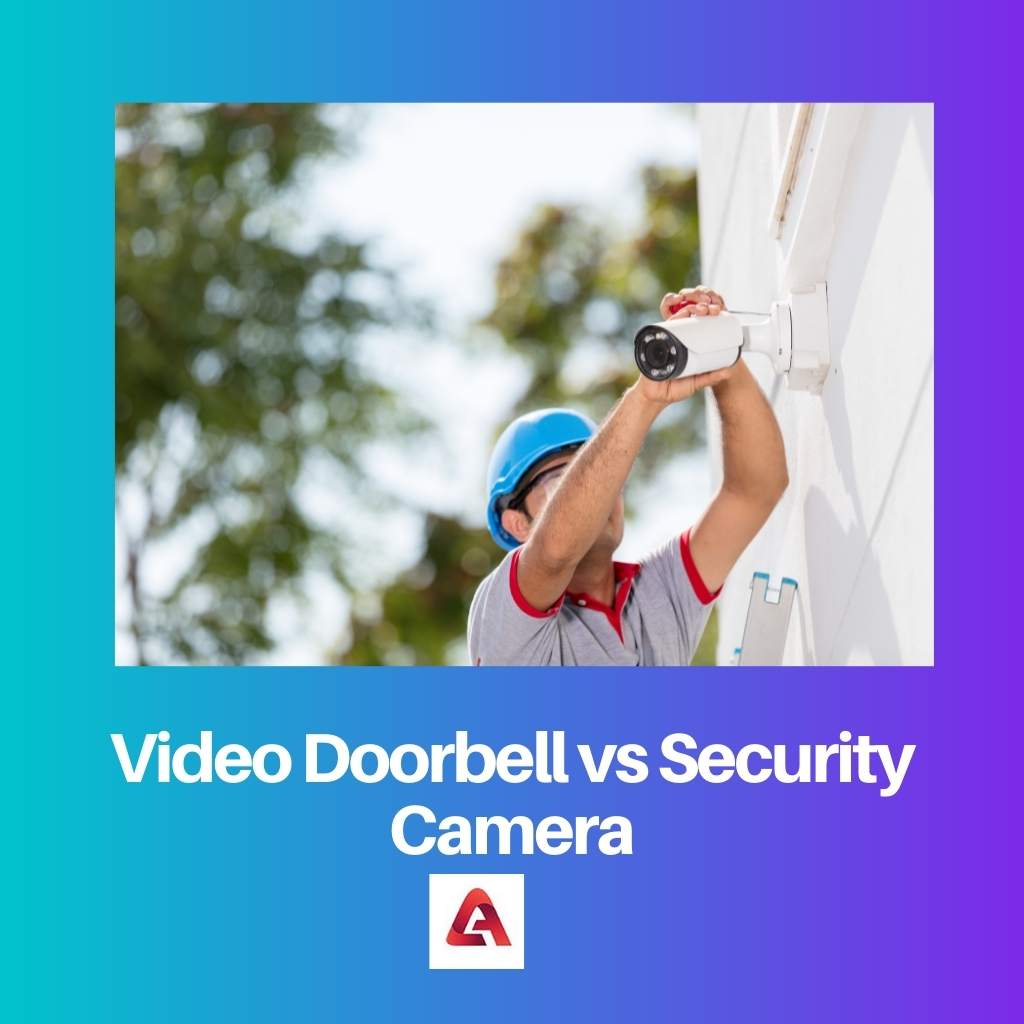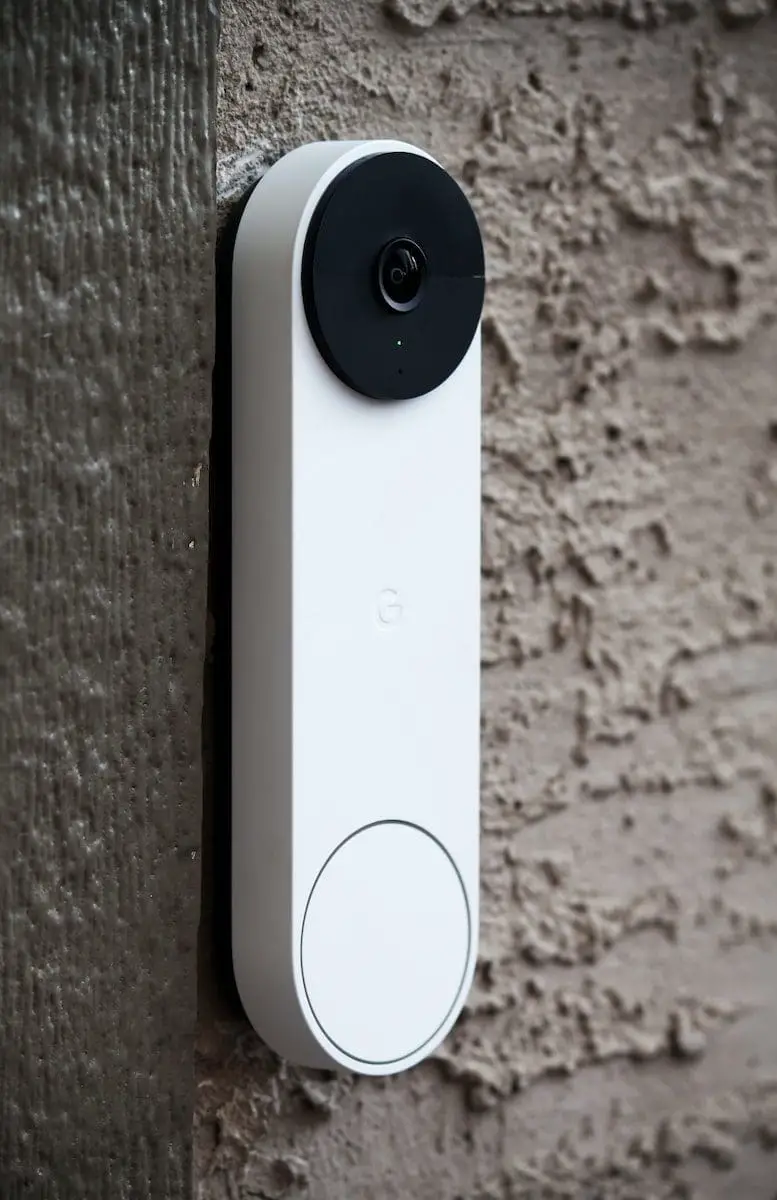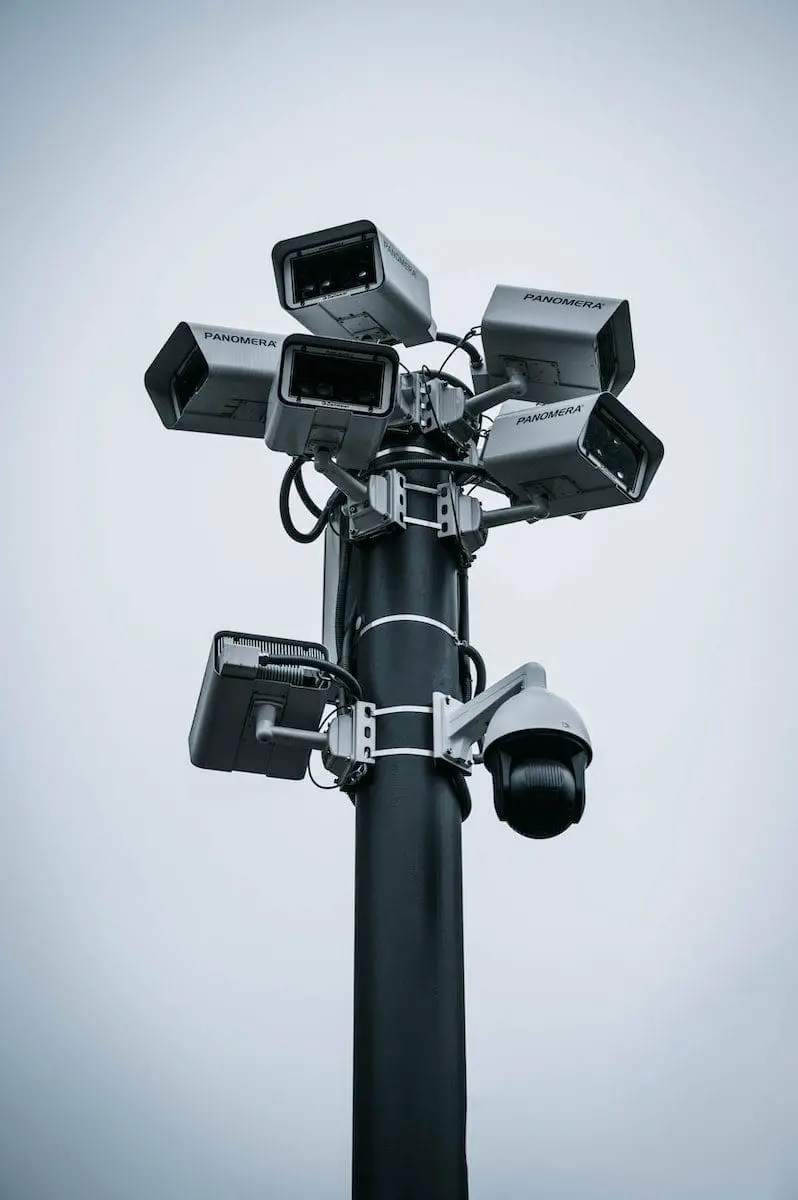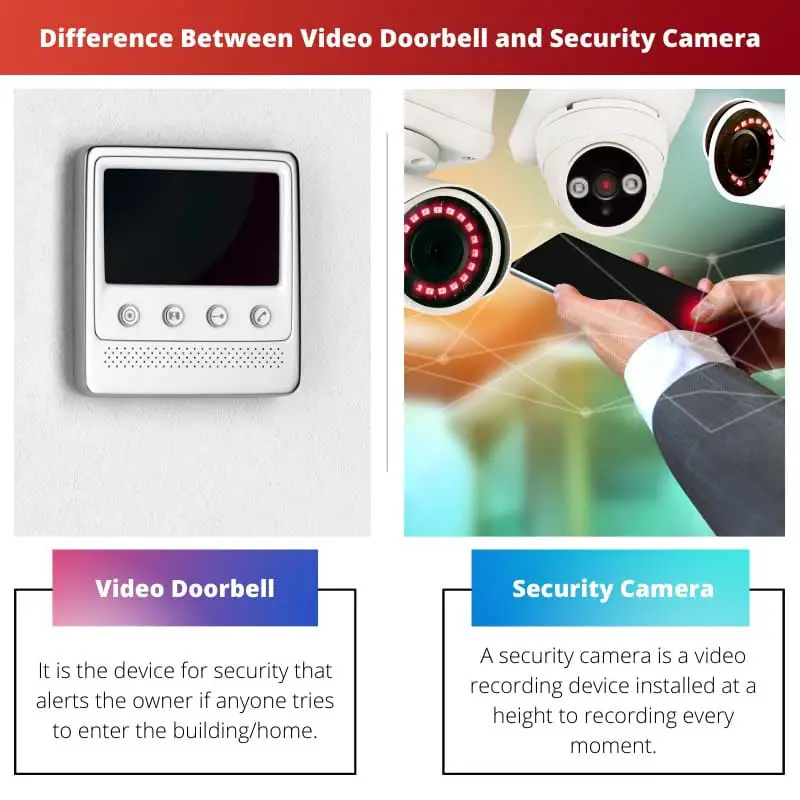Video Doorbell: Designed for front-door monitoring, it combines a doorbell with a camera, offering real-time video and two-way communication. Ideal for enhancing home security and managing deliveries.
Security Camera: Provides broader surveillance coverage for entire areas, indoors or outdoors. Offers continuous recording, motion detection, and higher resolution. Suitable for comprehensive home security beyond just the front entrance.
Key Takeaways
- Video doorbells are specifically designed for use at entry points, while security cameras can be used to monitor various areas.
- Video doorbells have two-way audio and allow for communication with visitors, while security cameras do not have this feature.
- Security cameras can be wired or wireless, while video doorbells are wireless.
Video Doorbell vs Security Camera
Video doorbells are designed to operate at doorbells and have a communication system to communicate with the visitors at the door. It notifies the people near the door using wifi on their smartphones. Security cameras are designed to operate at any corner of the house or in any area for security reasons.

Video Doorbell is a device placed at the door. It sends a notification by using the wifi to the smartphone if a person is near the door.
A security camera is a camera used for security purposes that records the video. This device tends to record high-quality video covering every angle and large area.
Comparison Table
| Feature | Video Doorbell | Security Camera |
|---|---|---|
| Primary Function | Monitors and interacts with visitors at the front door | Monitors a wider area for security purposes |
| Placement | Mounted next to the front door | Can be placed in various locations around the property |
| Field of View | Typically narrower (100-120 degrees) focused on the doorway | Wider field of view (180-360 degrees) can cover larger areas |
| Video Quality | Typically 1080p HD, some offer higher resolutions | More options for resolution (4MP to 12MP), potentially offering clearer details |
| Night Vision | Yes, but may be less advanced | Yes, with color night vision for better image quality |
| Two-Way Talk | Yes, allows communication with visitors | Not always available |
| Motion Detection | Yes, with customizable zones | Yes, may offer more customization and advanced features |
| Installation | Generally easier, can be wired or battery-powered | Can be more complex depending on location and wiring |
| Cost | Generally less expensive | Can range in price depending on features and complexity |
What is Video Doorbell?
A video doorbell is a modern and innovative home security device that combines traditional doorbell functionality with advanced video surveillance features. It serves as a digital peephole, allowing homeowners to see and interact with visitors remotely through a connected mobile device or computer. This technology has gained popularity for its ability to enhance home security and provide convenience.
How Video Doorbells Work
Camera and Sensors
Video doorbells are equipped with high-resolution cameras that capture live footage of the area surrounding the front door. In addition to the camera, they include motion sensors that trigger recording when motion is detected, even if the doorbell isn’t pressed. This feature enhances security by capturing activity outside the door.
Two-Way Audio
One of the standout features of video doorbells is the two-way audio communication. Users can talk to visitors through a built-in microphone and speaker on the doorbell. This functionality allows for seamless communication, whether it’s instructing a delivery person or warding off potential intruders.
Connectivity
Video doorbells connect to the homeowner’s Wi-Fi network, enabling real-time streaming of video and audio to a connected device. This connectivity also allows for remote access, making it possible to monitor the front door from anywhere with an internet connection.
Key Features
Remote Monitoring
With the help of dedicated mobile apps or web interfaces, users can remotely monitor their front door in real-time. This feature is particularly useful for homeowners who are away or for those who want to keep an eye on their property while inside their homes.
Motion Alerts
Video doorbells send push notifications or alerts to the user’s device when motion is detected. This instant notification allows for prompt action, such as checking the live feed to assess the situation or even communicating with the visitor.
Cloud Storage
To store video recordings and snapshots, many video doorbells offer cloud storage services. This ensures that footage is securely saved and can be accessed at a later time, providing evidence in case of suspicious activity or incidents.
Installation and Integration
Installation Process
Video doorbells are designed for easy installation, replacing existing wired doorbells or utilizing battery power for wireless models. The setup involves connecting the doorbell to the homeowner’s Wi-Fi network and configuring settings through the accompanying app.
Integration with Smart Home Systems
Many video doorbells integrate seamlessly with smart home ecosystems. They can be linked to other devices like smart locks, lighting systems, or security cameras, creating a comprehensive and interconnected home security network.
Considerations and Limitations
Power Source
Depending on the model, video doorbells may require a wired power source or operate on batteries. Wired options ensure a constant power supply, while battery-powered ones offer flexibility but may require more frequent recharging or battery replacement.
Privacy Concerns
As with any connected device, privacy is a consideration. Homeowners should be aware of how data is handled, stored, and protected. Opting for video doorbells from reputable manufacturers with strong privacy policies is crucial.

What is Security Camera?
A security camera, also known as a surveillance camera, is a device designed to monitor and record activities in a specific area to enhance security and safety. These cameras are widely used in various settings, including homes, businesses, public spaces, and governmental institutions.
Components of a Security Camera System
1. Camera
The core component, a security camera captures video footage and images. There are various types, including dome cameras, bullet cameras, and pan-tilt-zoom (PTZ) cameras, each with specific applications and features.
2. Lens
The lens determines the field of view and focal length, impacting the camera’s ability to capture detailed images. Varifocal lenses allow for adjustable focal lengths, providing flexibility in surveillance.
3. Image Sensor
The image sensor converts light into electronic signals, influencing the camera’s sensitivity to light (low-light performance) and image quality. Common types include CCD (Charge-Coupled Device) and CMOS (Complementary Metal-Oxide-Semiconductor).
4. Infrared LEDs
For night vision, many security cameras are equipped with infrared LEDs that illuminate the area without visible light. This is crucial for 24/7 surveillance.
5. Housing
Designed to protect the camera from environmental factors, housing varies based on the camera type and application. Weatherproof and vandal-resistant housings are common for outdoor cameras.
6. DVR/NVR
Digital Video Recorders (DVR) or Network Video Recorders (NVR) store and manage the recorded footage. DVRs are connected to analog cameras, while NVRs are used with IP cameras, providing more advanced features.
7. Cabling and Connectivity
Wired cameras require cables for power and data transmission, while wireless cameras use Wi-Fi or other wireless technologies. PoE (Power over Ethernet) simplifies installation by delivering power and data through a single cable.
Types of Security Cameras
1. Indoor Cameras
Designed for indoor use, these cameras are compact and discreet, suitable for monitoring interior spaces like homes, offices, or retail stores.
2. Outdoor Cameras
Built to withstand harsh weather conditions, outdoor cameras are durable and equipped with features like weatherproof housing, infrared LEDs, and tamper-resistant designs.
3. PTZ Cameras
Pan-Tilt-Zoom cameras offer remote control over the camera’s movement, allowing users to pan, tilt, and zoom to focus on specific areas.
4. Dome Cameras
With a dome-shaped design, these cameras are used for discreet surveillance. They are commonly seen in retail stores, casinos, and other public spaces.
Applications of Security Cameras
1. Home Security
Security cameras enhance home security by monitoring entry points, detecting intruders, and providing evidence in case of theft or vandalism.
2. Business Surveillance
Businesses use security cameras to protect assets, monitor employee activities, and ensure a secure working environment.
3. Public Safety
In public spaces, security cameras contribute to crime prevention, crowd management, and overall public safety.
4. Traffic Monitoring
Cameras are employed for traffic surveillance, monitoring road conditions, and managing traffic flow in urban areas.
Legal and Ethical Considerations
1. Privacy Concerns
The use of security cameras raises privacy issues, necessitating careful placement and adherence to regulations to respect individuals’ privacy rights.
2. Data Security
To prevent unauthorized access and potential misuse, securing the stored footage and data is crucial. Encryption and access controls play a significant role in data security.

Main Differences Between Video Doorbell and Security Camera
- Purpose:
- Video Doorbell: Primarily designed for monitoring and securing the entrance of a property, allowing users to see and communicate with visitors at the front door.
- Security Camera: Generally used for broader surveillance of a specific area or multiple areas, providing a comprehensive view of the surroundings.
- Placement:
- Video Doorbell: Typically installed near the front door to capture footage of visitors and activities at the entrance.
- Security Camera: Can be placed at various locations, covering a wider range such as the backyard, driveway, or other vulnerable areas.
- Features:
- Video Doorbell: Emphasizes features like two-way communication, motion detection at the doorstep, and integrates with smart home systems.
- Security Camera: Focuses on features like high-resolution video recording, night vision, wider field of view, and sometimes advanced analytics for detecting suspicious activities.
- Integration:
- Video Doorbell: Often designed to integrate with smart home ecosystems, allowing users to control and monitor the doorbell through their smartphones or other connected devices.
- Security Camera: Depending on the model, security cameras may also integrate with smart home systems, but their primary function is broader surveillance.
- Power Source:
- Video Doorbell: Typically powered by a wired connection to the existing doorbell wiring or a rechargeable battery.
- Security Camera: Power options vary, including wired connections, rechargeable batteries, or even solar power for outdoor cameras.
- Design:
- Video Doorbell: Compact and designed to fit seamlessly near the front door, with a focus on aesthetics to blend with the home’s exterior.
- Security Camera: May come in various designs, including bullet, dome, or PTZ (pan-tilt-zoom), and is more utilitarian in appearance.
- Cost:
- Video Doorbell: Generally more affordable compared to security cameras, as it serves a specific and focused function.
- Security Camera: Can be more expensive, especially for high-end models with advanced features and capabilities for extensive surveillance.
- Use Cases:
- Video Doorbell: Ideal for enhancing home security, convenience with package delivery, and monitoring who is at the front door.
- Security Camera: Suited for comprehensive surveillance of larger areas, deterring criminal activity, and providing evidence in the event of incidents.



